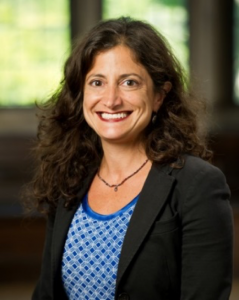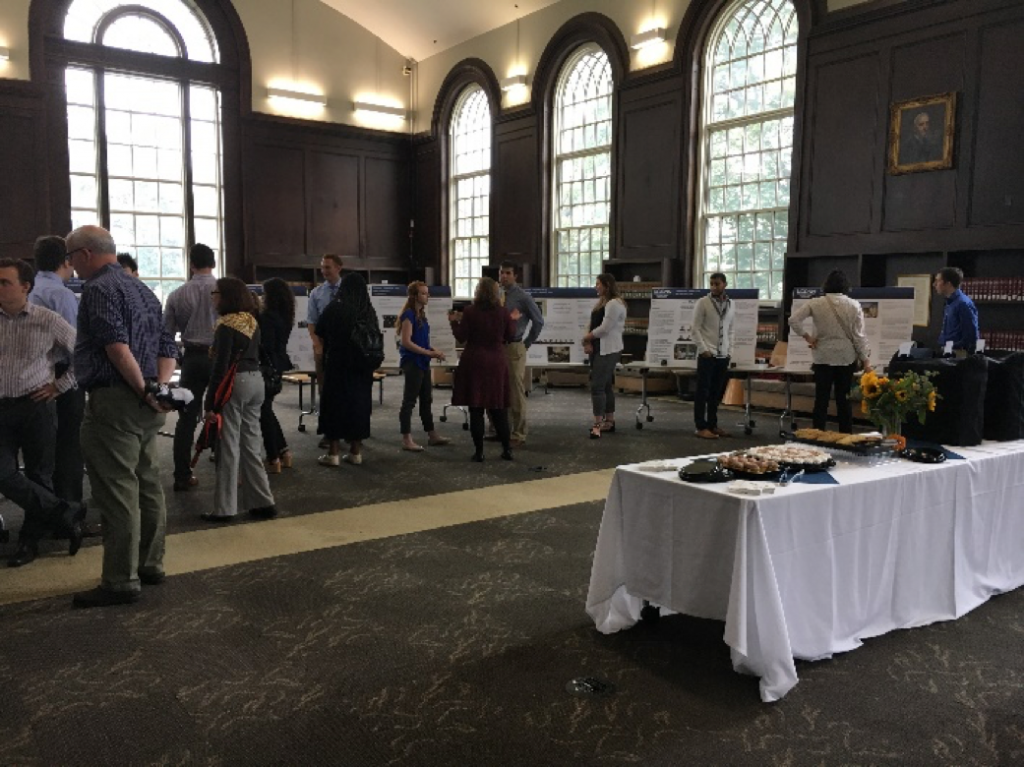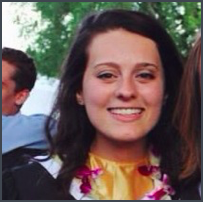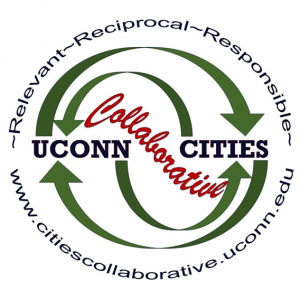Inquiry Based-Learning
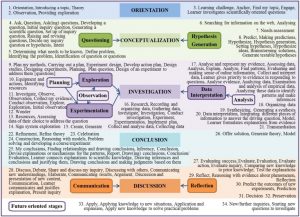
Inquiry Based Learning (IBL) is a learning philosophy grounded in the Socrative and Deweyan educational theories that centers “learners constructing knowledge through active investigation” (Jennings, 2010). IBL was born out of science education (see diagram to right), focusing on the scientific method. The specific of this model are: (a) orientation to concepts, (b) conceptualization of main course ideas to generate hypothesis, (c) investigation through the scientific method, (d) development of conclusions, and (e) discussion of findings through communication and reflection (Pedaste, et al., 2015).
Instructors determine the level of structure provided throughout this process and tends to be dependent on the developmental needs of students. Generally, IBL falls into three primary classifications based on the level of structure provided by the instructor: problem-based (least structured, students create inquiry), project-based (moderately-structured, faculty scaffold inquiry), and case-base teaching (most-structured, faculty control inquiry) (Adimoto, Goodyear, Bliuc, & Elli, 2013; Mills & Treagust 2003; Prince & Felder 2007). Structure refers to the level control students have in establishing their inquiry projects. An important feature of inquiry-based learning is that teachers and staff are “co-learners” who engage in instruction and creation of new knowledge through their research on teaching with IBL.
Scholars within the teaching and learning field have critiqued minimally-structured IBL for not recognizing that students are often novices with content, and therefore are unable to cognize both the content and the process of IBL in an effective and efficient manner (Kirschner, Sweller, & Clark, 2006). Additional critiques of IBL assert that not all students’ learning styles are honored through IBL (Healy Kneale, & Bradbeer, 2005). However, most research and discussion on IBL is focused on its applications within the K-12 education system, making both the relevance and critiques limited within the context of higher education.
Inquiry Based Learning in Higher Education
Aditomo et al. (2013) identified eight primary forms of Inquiry Based Learning in Higher Education that vary along dimensions of both research applicability and practice/content orientation. The eight forms identified are: role playing, enactment of practice, applied research, simulated applied research, discussion-based inquiry, lecture-based inquiry, simplified research, and scholarly research. The focus on the research process and scholarly projects noted above aligns with the larger goals of higher education, to both create new knowledge and prepare students for lifelong inquiry (Sproken-Smith, Matthews, & Angelo, 2007). Brew (2012) documented the need for instructing faculty to strengthen the links between teaching and scholarship by using an integrative model that has striking similarities to Inquiry Based Learning, showing the potential for IBL to serve as an effective to blend instruction and research. Implementation of this synergy within higher education occurs on various scales, with individual class projects as the granular level to entire institutional cultures such as Hampshire College (Justice, Rice, Roy, Hudspith, & Jenkins, 2009).
The United States, the movement toward integrated teaching and learning came into the national spotlight with both “Scholarship Reconsidered” (Boyer, 1990) and The Boyer Commission’s “Reinventing Undergraduate Education” (1998). In the latter publication, Inquiry Based Learning is emphasized numerous times through curricular recommendations focused on Research-Based Learning, Inquiry Based First Year Experiences, Capstone Experiences, and a general reprioritization synergy between teaching and research within the faculty reward systems. Specific studies of Inquiry Based Learning in Higher Education are minimal, with most published scholarship focusing on case studies with little empirical data.
Service Learning as IBL
Absent from nearly literature on Inquiry Based Learning is the alignment between IBL and service learning. Service Learning is defined as “a teaching and learning strategy that integrates meaningful community service with instruction and reflection to enrich the learning experience, teach civic responsibility, and strengthen communities” (The Carnegie Foundation). Service learning is based on Dewyan philosophies of education, with a learning process grounded in Kolb’s model of experiential learning. Scholars have identified three primary forms of service learning: direct service learning, indirect service learning, and advocacy based service learning (Furco, 1996). In direct service learning, students are placed into community sites and come in contact with people and service, whereas indirect service learning involves less contact with community members and service is often performed through full or partial research projects. Advocacy/Civic Action service learning is indirect and action-oriented, often with an emphasis on changing public policy or educating the general public or specific stakeholders around a community-partner identified issue.
Based on the definition of Inquiry Based Learning established above, certain features of service learning must be included for Service Learning to fall within Inquiry Based Learning. The most ambiguous form of service learning, Direct Service Learning, may not be inclusive of the investigatory nature of IBL. While direct service activities such as office support at a non-profit provides a rich learning environment, if the service experience is not grounded in exploration of academic questions created or co-created by the student, IBL is not met. Indirect service learning is more likely to align with IBL as students often engage on a research driven project with parameters established by their instructors and community partners. While the most extreme believers in IBL would find limitations based on the students’ more limited ability to shape their inquiry, the method, process, and applicability of this form of service learning fall in line with problem-based inquiry.
Moreover, indirect service learning experience often fit into a variety of disciplines and student learning experiences including capstones, community-based action research, service internships, and problem-based service learning (Heffernan, 2001). Many of these iterations of service learning follow the research progression described in the Inquiry Based Learning Process. One strong alignment between Service Learning and IBL is that the service learning experience creates opportunity to maximize the integration of teaching and scholarship for faculty, by conducting research with students and community partners through community engaged scholarship (Bringle & Hatcher, 1995). However, intentional effort must be made by faculty who are seeking to bridge learning and scholarship with community partners to prevent exploitation and assure a relevant and reciprocal partnership.
One area of limitation between the two theories is the focus of learning as noted in the discussion above. IBL prioritizes student learning, whereas SL requires that instructor balance competing interests between students and community partners’ needs, ultimately limiting the level of control students’ have over their projects and experiences. Another major difference between the two learning philosophies is their orientation toward social justice. Service learning, as a scholarly field, is moving toward a social justice oriented approach toward instruction (see Butin, 2015; Mitchell, 2008; Stoecker, 2016) whereas little within the specific literature on IBL is speaking to equity. On the whole, service learning allows for further alignment of teaching and scholarly practices and for integration of inquiry-based student learning.
References
Aditomo, A., Goodyear, P., Bliuc, A. M., & Ellis, R. A. (2013). Inquiry-based learning in higher education: principal forms, educational objectives, and disciplinary variations. Studies in Higher Education, 38(9), 1239-1258.
Boyer, E. L. (1990). Scholarship reconsidered: Priorities of the professoriate. Princeton, NJ: Princeton University Press.
Boyer Commission on Educating Undergraduates in the Research University, S. S. Kenny (chair). Reinventing Undergraduate Education: A Blueprint for America’s Research Universities. State University of New York–Stony Brook, 1998.
Brew, A. (2012). Teaching and research: New relationships and their implications for inquiry-based teaching and learning in higher education. Higher Education Research & Development, 31(1), 101-114.
Butin, D. (2015). Dreaming of justice: Critical service-learning and the need to wake up. Theory Into Practice, 54(1), 5-10.
Healey, M., Kneale, P., & Bradbeer, J. (2005). Learning styles among geography undergraduates: an international comparison. Area, 37(1), 30-42.
Jennings, L. B. (2010). Inquiry-Based Learning. In Encyclopedia of Educational Reform and Dissent. (pp. 467-468). Thousand Oaks, CA: SAGE Publications, Inc.
Justice, C., Rice, J., Roy, D., Hudspith, B., & Jenkins, H. (2009). Inquiry-based learning in higher education: administrators’ perspectives on integrating inquiry pedagogy into the curriculum. Higher Education, 58(6), 841.
Kirschner, P. A., Sweller, J., & Clark, R. E. (2006). Why minimal guidance during instruction does not work: An analysis of the failure of constructivist, discovery, problem-based, experiential, and inquiry-based teaching. Educational psychologist, 41(2), 75-86.
Mills, J.E. and Treagust, D.F. (2003). Engineering education – is problem-based or project-based learning the answer? Australasian Journal of Engineering Education, 11, pp. 2-16.
Mitchell, T. D. (2008). Traditional vs. critical service-learning: Engaging the literature to differentiate two models. Michigan Journal of Community Service Learning, 14(2).
Pedaste, M., Mäeots, M., Siiman, L. A., De Jong, T., Van Riesen, S. A., Kamp, E. T., … & Tsourlidaki, E. (2015). Phases of inquiry-based learning: Definitions and the inquiry cycle. Educational research review, 14, 47-61.
Prince, M., & Felder, R. (2007). The many faces of inductive teaching and learning. Journal of college science teaching, 36(5), 14.
Spronken-Smith, R., Angelo, T., Matthews, H., O’Steen, B., & Robertson, J. (2007). How effective is inquiry-based learning in linking teaching and research. An international colloquim on international policies and practices for academic enquiry. Marwell, Winchester.
Stoecker, R. (2016). Liberating service learning and the rest of higher education civic engagement. Temple University Press.
